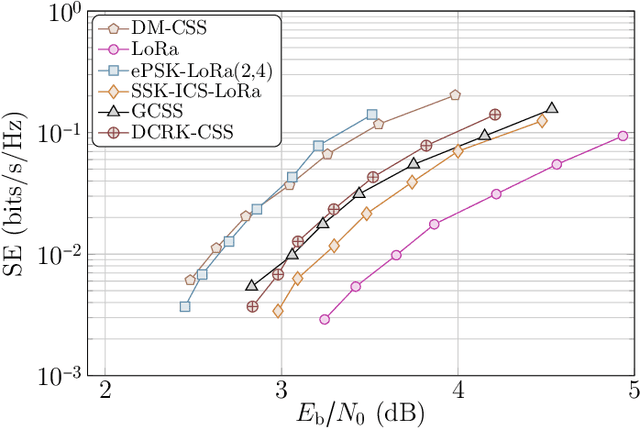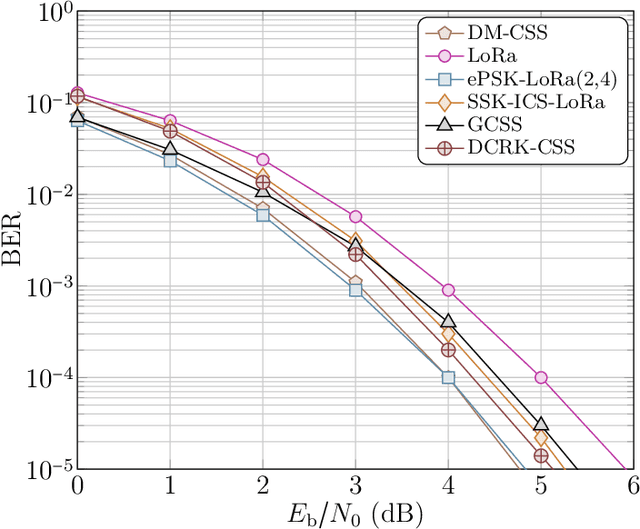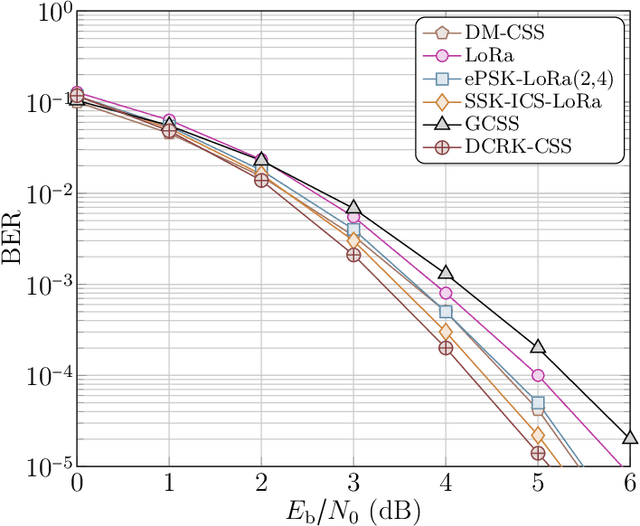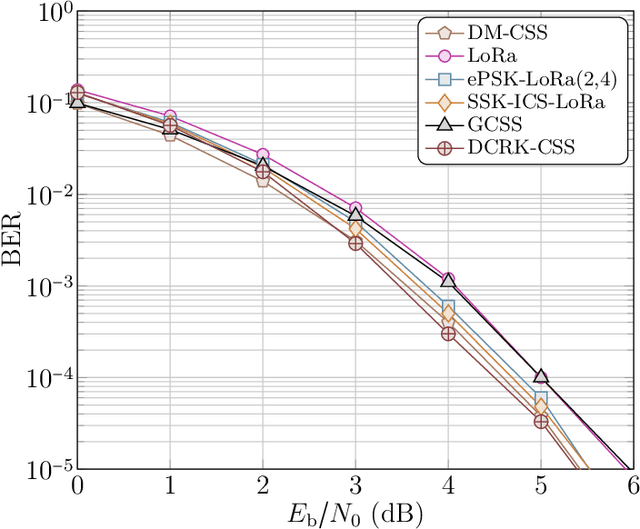Raed Shubair
Layered Chirp Spread Spectrum Modulations for LPWANs
May 29, 2024Abstract:This article examines two chirp spread spectrum techniques specifically devised for low-power wide-area networks (LPWANs) to optimize energy and spectral efficiency (SE). These methods referred to as layered CSS (LCSS) and layered dual-mode CSS (LDMCSS), involves utilizing multiple layers for multiplexing symbols with varying chirp rates. These waveform designs exemplify a high degree of SE compared to existing schemes. Additionally, LDMCSS necessitates a lesser number of layers than LCSS to attain comparable SE, thereby reducing computational complexity. These proposed techniques can employ coherent and non-coherent detection and can be adjusted to achieve various spectral efficiencies by altering the number of multiplexed layers. Unlike our proposed LCSS and LDMCSS, other CSS alternatives for LPWANs cannot provide the same level of flexibility and SE. The performance of these techniques is evaluated in terms of bit error rate under different channel conditions, as well as with phase and frequency offsets.
Dual-Mode Time Domain Multiplexed Chirp Spread Spectrum
Oct 08, 2022



Abstract:We propose a dual-mode (DM) time domain multiplexed (TDM) chirp spread spectrum (CSS) modulation for spectral and energy-efficient low-power wide-area networks (LPWANs). DM-CSS modulation that uses both the even and odd cyclic time shifts has been proposed for LPWANs to achieve noteworthy performance improvement over classical counterparts. However, its spectral efficiency (SE) is half of the in-phase and quadrature (IQ)-TDM-CSS scheme that employs IQ components with both up and down chirps, resulting in a SE that is four times relative to Long Range (LoRa) modulation. Nevertheless, the IQ-TDM-CSS scheme only allows coherent detection. Furthermore, it is also sensitive to carrier frequency and phase offsets, making it less practical for low-cost battery-powered LPWANs for Internet-of-Things (IoT) applications. DM-CSS uses either an up-chirp or a down-chirp. DM-TDM-CSS consists of two chirped symbols that are multiplexed in the time domain. One of these symbols consisting of even and odd frequency shifts (FSs) is chirped using an up-chirp. The second chirped symbol also consists of even and odd FSs, but they are chirped using a down-chirp. It shall be demonstrated that DM-TDM-CSS attains a maximum achievable SE close to IQ-TDM-CSS while also allowing both coherent and non-coherent detection. Additionally, unlike IQ-TDM-CSS, DM-TDM-CSS is robust against carrier frequency and phase offsets.
A Survey on Chirp Spread Spectrum-based Waveform Design for IoT
Aug 22, 2022



Abstract:Long Range (LoRa) is one of the most promising and widespread chirp spread spectrum (CSS)-based physical (PHY) layer technique for low-power wide-area networks (LPWANs). Using different spreading factors, LoRa can attain different spectral/energy efficiencies, and can target multitude of Internet-of-Thing (IoT) applications. However, one of the limiting factors for LoRa is the low bit rate. Little to no effort has been made in order to improve the achievable rate of LoRa, until recently, when a number of CSS-based PHY layer LoRa alternative are proposed for LPWANs. In this survey, for the first time, we present a comprehensive waveform design of these CSS-based schemes that have been proposed between 2019 to 2022. In total, fifteen alternatives to LoRa are compared. Other survey articles related to LoRa mostly tackle different issues, such as LoRa networking, LoRa deployment in massive IoT networks, and LoRa architectures, etc. This survey, on the other hand, comprehensively elucidates the waveform design of LoRa alternatives. The CSS schemes studied in this survey are divided into single chirp, multiple chirp, and index modulation based on the multiplexing pattern of the chirps. Complete transceiver architecture of these CSS schemes is studied, and performance is evaluated in terms of energy efficiency (EE), spectral efficiency (SE), bit-error rate (BER) performance in additive white Gaussian noise, BER in the presence of phase and frequency offsets. It has been observed that the EE, SE and robustness against the offsets is primarily linked to transmit symbol frame structure. The public versions of the MATLAB codes for the CSS schemes studied in this survey shall be provided to promote reproducible research.
Dual-Mode Chirp Spread Spectrum Modulation
May 19, 2022



Abstract:In this letter, we propose novel dual-mode chirp spread spectrum (DM-CSS) modulation for low-power wide-area networks for Internet-of-Things applications. DM-CSS is capable of transmitting higher number of bits relative to other counterparts, such as Long Range (LoRa) modulation. Considering the same symbol period, the number of transmitted bits in DM-CSS are augmented by: (i) simultaneously multiplexing even and odd chirp signals; (ii) using phase shifts of \(0\) and \(\pi\) radians for both even and odd chirp signals; and (iii) using either up-chirp or down-chirp signal. Relative to LoRa, the transmitted bit rate increases by up to \(116.66\%\) for the same bandwidth and spreading factor. Moreover, we present a non-coherent receiver architecture for DM-CSS. Simulation results reveal that DM-CSS is not only more spectral efficient but also more energy efficient than most classical counterparts. It is also demonstrated that DM-CSS is robust to phase and frequency offsets.
 Add to Chrome
Add to Chrome Add to Firefox
Add to Firefox Add to Edge
Add to Edge